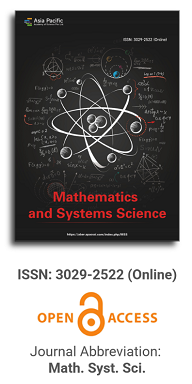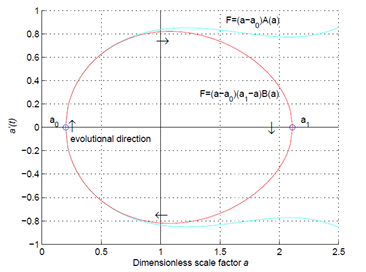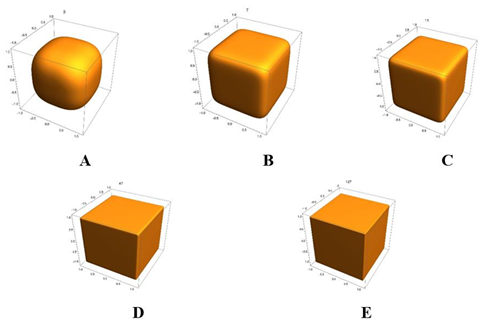


Full Issue
| View or download the full issue |
Issue release: 31 March 2025
The dynamics of a composite consisting of the nonlinear multilayer beam structure, interacting through elastic intermediate layers, under mobile point loading is investigated. This study finds a direct application in transport engineering technologies, more precisely in railways, where the moving point load is the train, and the multilayer beam, the rails interacting with the ballast, the foundation and base layers. From the Lagrange formulations, the system of damping partial differential equations of the model is found, and by considering the non-dissipative case with weak nonlinearity and constant charge they are used to find the eigen modes and the natural vibration frequencies of the system. Then the dissipative case with nonlinearity is studied, with a particular attention carried on the temporal part, which is reduced to a system of coupled nonlinear differential equations, where the first line is forced. This system of equation is used to determine the equilibrium points, after which they are subsequently solved analytically through the multiple time scale method for harmonic resonance case, showing the formation of hysteresis more and more complex as the number of cells increases. The coupled nonlinear equations of the system is next solved numerically, with the transition of the system towards chaos analyzed through the bifurcation diagram and the maximum Lyapunov exponent, which show strong sensitivity to the coupling parameter λ2 as well as the system frequency. The results show for N = 2 and for some parameters the periodic behavior and the crisis for ω = 0.5. When the frequency is low; that is ω = 0.05 the chaotic band is considerably reduced, chaos appearing around the nonlinearity parameter γ2 = 0.5 and also for γ2 > 0.85. The time trace shows chaotic pulses and bursting type behavior, for some choices of the coupling parameter. The synchronization curves are also plotted and it is shown that q2 doesn’t synchronizes with q1 for some frequencies, while for others parameters, they synchronize, but fairly. For N = 3, the dynamics is more complex and the time traces plots show regular impulse for ω = 0.5 and bursting for weak frequency, ω = 0.05.
Issue release: 31 March 2025
In this research paper, a spectral method is used for numerically solving the time-fractional diffusion equation as the time fractional diffusion equations are a powerful tool for simulating physical systems. We employ the Lucas polynomials (LPs) with Petrov-Galerkin for the linear combination basis. The main idea of the proposed technique is to convert the governed boundary-value problem into a system of linear algebraic equations by applying the Petrov-Galerkin method. Many procedures can solve the resulting linear system. The method’s accuracy is shown through several examples.
Issue release: 31 March 2025
Characterization of posinormal operators in terms of their positivity, invertibility and numerical ranges has been done. However, characterization of these operators with regards to their closed ranges remains interesting. In this work, we characterize conditions for posinormal operators to have closed ranges. In particular, we establish an important upper norm bound criterion for posinormal operators. We show that if Q, R are normal operators in PN (H), the set of all posinormal operators acting on a Hilbert space H and suppose that the range of Q is closed with the null space of Q equal to the null space of R, then the range of R is closed. The results of this study are very useful applications in many areas, like image and signal processing. In particular, they are useful in processing signals and images used in facial recognition which are important in the identification of people in places like the airports, thus helping in enhancing security and forensic analysis.
Issue release: 31 March 2025
This paper examines the supply chain resilience of Taiwan Semiconductor Manufacturing Co. (TSMC) using a Bayesian network (BN) model developed from the Supply Chain Operations Reference (SCOR) framework. This hybrid model allows for an integrated analysis of various key performance indicators (KPIs) across TSMC’s supply chain, providing a comprehensive view of its resilience. By simulating multiple disruption scenarios, the study captures the dynamic interactions and cascading effects of disruptions, such as inventory shortages, transportation delays, and labor cost fluctuations. This approach offers a quantitative analysis of TSMC’s resilience under varied scenarios, revealing critical strengths, such as flexibility in resource allocation, as well as vulnerabilities, particularly in response to high-impact events like geopolitical tensions and natural disasters. Insights from this model highlight the areas where strategic improvements can further strengthen resilience. Overall, the research demonstrates the applicability of Bayesian networks as a powerful tool for resilience assessment, not only in TSMC’s context but also as a scalable solution for other high-complexity, high-dependency supply chains within the semiconductor industry. This study contributes valuable knowledge to the broader field of supply chain resilience and advances the methodologies available for industry practitioners and researchers alike.
Issue release: 31 March 2025
Soft sets provide a strong mathematical foundation for managing uncertainty and inventing solutions to parametric data problems. Soft set operations are fundamental elements within soft set theory. In this paper, we introduce a new product operation for soft sets, called the “soft lambda-product,” and thoroughly examine its algebraic properties in relation to various types of soft equalities and subsets. By studying the distribution of the soft lambda-product over different soft set operations, we further investigate its relationship with other soft set operations. We conclude with an example demonstrating the method’s effectiveness across various applications, employing the int-uni operator and int-uni decision function within the soft lambda-product for the int-uni decision-making method, which identifies an optimal set of elements from available options. This work significantly contributes to the soft set literature, as the theoretical foundations of soft computing methods rely on solid mathematical principles.
Issue release: 31 March 2025
The optimal size of a military force to send to the battle field is determined. The objective function includes the cost of deployment, the cost of the time it takes to win the battle, and the costs of killed and wounded soldiers with equipment. The cost of deployment is an explicit function of the number of deployed troops and the value of a victory with access to a free territory, is a function of the length of the time it takes to win the battle. The cost of lost troops and equipment, is a function of the size of the reduction of these lives and resources. An objective function, based on these values and costs, is optimized, under different parameter assumptions. The battle dynamics is modeled via the Lanchester differential equation system based on the principles of directed fire. First, the deterministic problem is solved analytically, via derivations and comparative statics analysis. General mathematical results are reported, including the directions of changes of the optimal deployment decisions, under the influence of alternative types of parameter changes. Then, the first order optimum condition from the analytical model, in combination with numerically specified parameter values, is used to determine optimal values of the levels of deployment in different situations. A concrete numerical case, based on the Battle of Iwo Jima, during WW Ⅱ, is analyzed, and the optimal deployment decisions of the attacker, BLUE, are determined under different assumptions. The known attrition coefficients of both armies, BLUE, and the defender, RED, and the initial size of the RED force, are parameters. The optimal solutions are found via Newton- Raphson iteration. Finally, a stochastic version of the optimal deployment problem is defined, where the attrition parameters are considered as stochastic, before the deployment decisions have been made.
Issue release: 31 March 2025
This study aims to investigate the effects of implicit numerical excitation on the receptivity of flow inside a square lid-driven cavity (LDC) leading to bifurcation and instability for a fixed (257 × 257) grid with different temporal resolutions via the solution of the Navier-Stokes equation. Computational results have been provided showing the flow dynamics of the LDC problem as explained with a time series at a representative point near the top corner of the cavity at (0.95, 0.95) for supercritical Reynolds numbers with respect to the bifurcation phenomenon by lowering the time step. As the accuracy of numerical methods plays a vital role in capturing the dynamics at different Reynolds numbers, this vortex-dominated flow is explained for bifurcation and instability. We propose this as a benchmark problem for the direct numerical simulation (DNS) and for machine learning (ML) of fluid flow that will lead to efficient ML algorithms and an understanding of flow receptivity, instability, and transition by DNS.
Issue release: 31 March 2025
The parametric rough bi-level multi-objective fractional programming problem (PRBL-MOFPP) is investigated in this article. In the right-hand aspect of the rough set of constraints, the suggested PRBL-MOFPP has a scalar parameter. The PRBL-MOFPP is converted into two issues congruent to the upper and lower approximation models (UAM and LAM) in the first phase. Both UAM and LAM are solved using the fuzzy goal programming (FGP) technique. The parametric UAM and LAM were formulated in the second phase, and the Lagrangian function for UAM and LAM was derived. Furthermore, both models were subjected to Karush-Kuhn-Tucker (KKT) optimality conditions. Finally, the surely and possibly stable set of the first kind (SSFK) are studied. An algorithm for determining the SSFK for PRBL-MOFPP, as well as numerical examples, are exhibited.
Issue release: 31 March 2025
Issue release: 31 March 2025
This note delves into the convergence analysis of several iterative methods and elucidates their behaviors. Furthermore, we demonstrate that the findings presented in “A new three-step fixed point iteration scheme with strong convergence and applications” are not entirely novel. In particular, some of the results either overlap with or restate previously established methods without introducing significant innovations.
Editor-in-Chief

Prof. Youssri Hassan Youssri
Cairo University, Egypt
Asia Pacific Academy of Science Pte. Ltd. (APACSCI) specializes in international journal publishing. APACSCI adopts the open access publishing model and provides an important communication bridge for academic groups whose interest fields include engineering, technology, medicine, computer, mathematics, agriculture and forestry, and environment.


 Open Access
Open Access
.jpg)

.jpg)
